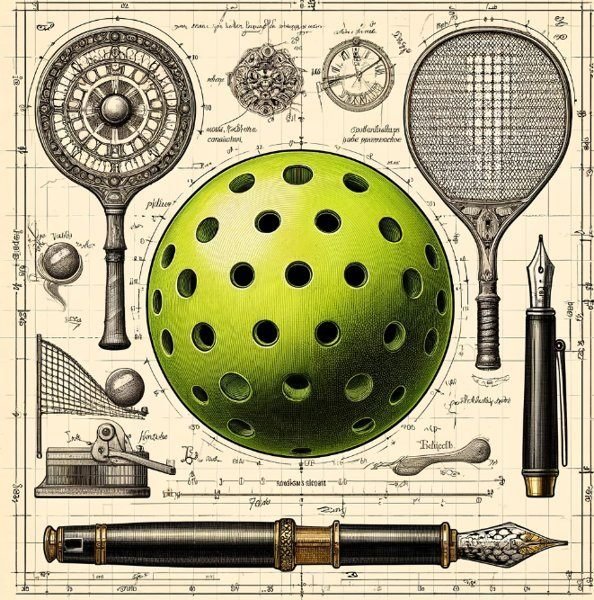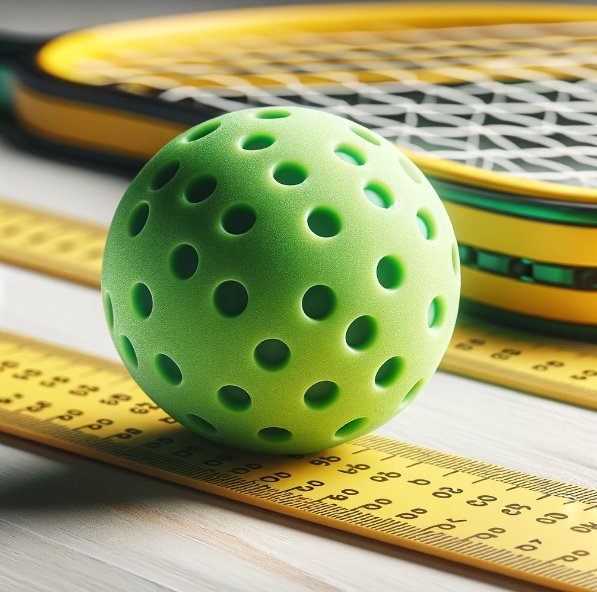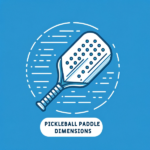When it comes to playing pickleball, the pickleball ball size is a crucial factor that can impact your game. Whether you’re a seasoned player or just picking up the paddle, understanding the right ball size ensures you play your best. In this article, we’ll dive into everything you need to know about pickleball ball size, official regulations, and how to choose the right ball for your game.
Table of contents
Understanding Pickleball Ball Size
Pickleball balls come in various sizes, but the standard diameter of a pickleball ranges between 2.874 inches (7.3 cm) and 2.972 inches (7.55 cm). This slight variance can affect the ball’s bounce and flight, making it essential to choose the correct size for your play style.

Why Size Matters
- Control and Accuracy: A ball that’s too large or too small can throw off your shots.
- Consistency: Playing with the same size of a pickleball ball every game ensures a consistent playing experience.
- Regulation Play: Official tournaments adhere to specific ball size regulations, so practicing with the correct size is beneficial.
Official Regulations and Standards
According to the USA Pickleball Association (USAPA), the pickleball ball size must meet the following standards:
- Diameter: 2.874 inches to 2.972 inches (7.3 cm to 7.55 cm)
- Weight: 0.78 to 0.935 ounces (22.1 to 26.5 grams)
- Bounce: When dropped from a height of 78 inches (198.1 cm), the ball should bounce between 30 to 34 inches (76.2 to 86.4 cm)
- Material: Usually made of durable plastic
- Colors: Common colors include yellow, white, and orange
- Holes: Balls typically have 26 to 40 holes
These standards ensure fair play and consistency across all levels of the sport.
Choosing the Right Ball for Your Game
Choosing the right ball depends on several factors, including the playing environment and personal preference.
Indoor vs. Outdoor Balls
| Feature | Indoor Balls | Outdoor Balls |
| Holes | 26 (larger holes) | 40 (smaller holes) |
| Weight | 0.81 ounces (23 grams) | 0.88 ounces (25 grams) |
| Durability | Softer, less durable | Harder, more durable |
| Wind Resistance | Less wind resistance | More wind resistance |
| Usage | Indoor courts | Outdoor courts |
| Bounce | Lower, suitable for smooth indoor surfaces | Higher, suitable for rough outdoor surfaces |
Practical Tips
- Test Different Balls: Try out different sizes within the regulation range to find what suits your play style.
- Consider the Environment: Use indoor balls for indoor courts and outdoor balls for outdoor courts to optimize your game.
Frequently Asked Questions
Why Do Pickleball Balls Have Holes?
Pickleball balls have holes to reduce wind resistance, which helps in controlling the ball’s flight. The number of holes typically ranges from 26 to 40, depending on whether the ball is designed for indoor or outdoor play.
What Is a Pickleball Made Of?
Pickleball balls are usually made of durable plastic. This material is chosen for its ability to withstand the impact of play and provide a consistent bounce.
What Are the Common Colors of Pickleball Balls?
Common colors for pickleball balls include yellow, white, and orange. These bright colors are chosen to improve visibility during play, especially in varying lighting conditions.
How Big Is a Pickleball Ball?
The diameter of a pickleball ball typically ranges between 2.874 inches (7.3 cm) and 2.972 inches (7.55 cm).
How Much Does a Pickleball Weigh?
The pickleball ball weight ranges from 0.78 to 0.935 ounces (22.1 to 26.5 grams).
What’s the Difference Between Indoor and Outdoor Pickleball Balls?
The main differences between indoor and outdoor pickleball balls lie in their weight, hole size, and durability. Indoor balls are lighter with larger holes, making them ideal for indoor play, while outdoor balls are heavier with smaller holes to withstand outdoor elements.
How Do You Choose the Right Pickleball Ball?
Choosing the right pickleball ball involves considering where you play (indoors or outdoors), your personal preference for ball weight and feel, and testing different balls to see which one fits your play style best.
Comparison: Wiffle Balls vs. Pickleballs
Wiffle balls and pickleballs are often confused due to their similar appearance, but they have distinct differences. Here’s a detailed comparison:
| Feature | Wiffle Balls | Pickleballs |
| Material | Soft plastic | Durable plastic |
| Diameter | 2.87 inches (7.29 cm) | 2.874 to 2.972 inches (7.3 to 7.55 cm) |
| Weight | 0.7 ounces (19.8 grams) | 0.78 to 0.935 ounces (22.1 to 26.5 grams) |
| Holes | 8 large holes | 26 to 40 smaller holes |
| Usage | Backyard games, informal play | Formal pickleball games, competitive play |
| Durability | Less durable, can crack easily | More durable, designed for repeated impact |
| Bounce | Lower bounce, unpredictable flight | Higher bounce, controlled flight |

Are Wiffle Balls and Pickleballs the Same?
No, wiffle balls and pickleballs are not the same. While they may look similar, their construction, usage, and play characteristics differ significantly. Wiffle balls are typically used for casual backyard games and are made of softer plastic with fewer holes, leading to a more unpredictable flight. Pickleballs, on the other hand, are designed for the sport of pickleball, made of durable plastic with numerous smaller holes, providing a consistent bounce and controlled flight suitable for competitive play.
Conclusion
Understanding the pickleball ball size is essential for improving your game and ensuring consistency. Whether you’re playing for fun or in a competitive setting, choosing the right ball can make a significant difference. So, next time you hit the court, you’ll know exactly which ball to pick for the best performance.



